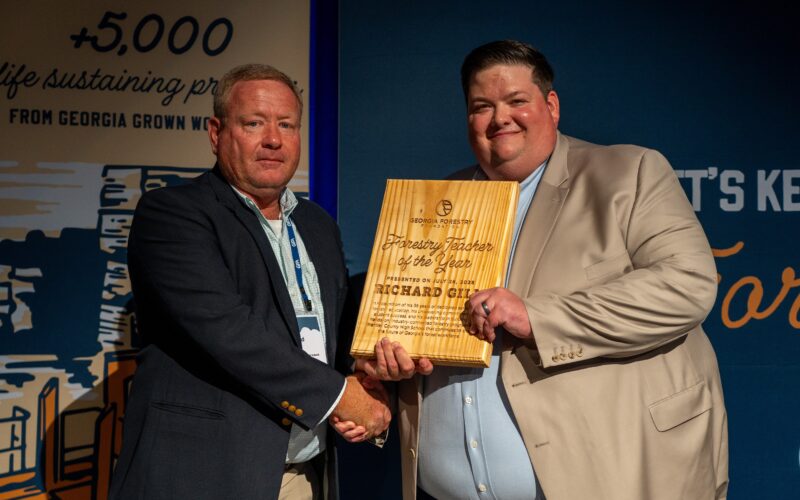The sign outside of Mac 44 Trucking in Offerman, Georgia, reads “Now Hiring Experienced Timber Relocators.” Recruiting qualified, safe log truck drivers is just one of the many issues that owner Tracy Harris faces. But there is one issue that remains at the top of his list, one that he works on daily, and one that has the highest impact on his business – trucking insurance.
For Georgia’s forestry industry to remain competitive, the state’s logging sector, which provides vital connectivity from the forest to mills, must remain profitable. So, the Georgia Forestry Foundation’s Center for Forest Competitiveness worked together with the Warnell School of Forestry and Natural Resources at the University of Georgia to research the changes in log truck liability insurance, identify the reasons for rate increases and make recommendations on how companies can combat higher insurance prices.
“Insurance has gone up every year even if there were no losses in the previous year,” said Harris whose company serves as a contract trucking operation with more than 60 trucks. “It takes a lot from my bottom line to pay additional premiums, which takes revenue away from growing and sustaining the business.”

The Warnell School conducted a survey of logging company owners last year that showed that transportation costs and trucking insurance were the second and third highest concerns for logging businesses across the state.
“Georgia is the number one forestry state in the nation,” Andres Villegas, president of the Georgia Forestry Association, said. “That is only possible when the entire forestry supply chain is profitable – we all rely on each other.”
Hauling timber accounts for 25-45 percent of overall timber harvesting costs in Georgia. The highest volume of wood is hauled by small to mid-sized operations with 3-10 trucks. In recent years, liability insurance premiums have put a large amount of stress on the average-size operation, with some experiencing up to 300 percent increases and others being denied coverage completely.
For companies like Sanders Logging Company, insurance rates can significantly impact the overall success of the business.
“It’s a tough deal,” Vice President Harry Sanders said. “Our business already operates under extremely tight margins due to the rates we are paid today. Over the past several years, our insurance rates have gone up, and it doesn’t match the compensation we are receiving. It just doesn’t match up.”

How Significant is the Issue?
A study led by Dr. Joseph Conrad, assistant professor of forest operations at the Warnell School, showed that log truck liability insurance premiums in Georgia increased by 53 percent from 2011-2016. During the same period, premiums for other heavy vehicles (not log trucks) increased only by 12 percent.
The study also examined how Georgia compared to similar states in the Southeast. Georgia is ranked first in the nation for volume of timber harvested, and Alabama and North Carolina are ranked second and third. In 2016, Georgia’s log truck liability insurance premiums were 17% higher than Alabama’s and 94% higher than North Carolina’s.
Georgia has experienced these increases despite a 70 percent decrease in total log truck accidents from 2006-2012 and a marked decrease in accident severity during the same period.
So, Why Are Rates Still Increasing?
“There are a number of factors, but from the insurers perspective, log trucks simply provide high risk with very limited profit in many cases,” Dr. Conrad said.
Log trucks are inherently different than other commercial trucks. The trucks spend time on rough forest roads, and the operators require a significant amount of training and experience to operate safely. Combine those factors with a shortage of professional commercial drivers, and insuring log trucks becomes difficult.
In 2010, a crowded market of insurance carriers kept insurance premium rates low to win business. When rates declined and claims increased, insurance companies suffered losses, causing as many as half of the insurance carriers to temporarily or permanently cease offering log truck insurance in Georgia.
Even though the overall number of accidents and severity of accidents has decreased, the cost of insurance claims has steadily increased. The combination of litigation, increases in medical costs, and increases in vehicle repair costs result in far more accidents being “policy limit” claims. For some insurance providers, the premiums collected for safe trucks have not been sufficient to cover the claims from accidents.
How Do We Address the Issue?
Dr. Conrad’s report provided several recommendations for addressing the issue of log trucking, and the Georgia Forestry Association will be working with the entire forestry community to determine the best possible strategy for the sector. The recommendations include:
- Insurance Reform
Some states have seen success in passing legislation to fundamentally change how insurance coverage works. In 1973, the North Carolina Reinsurance Facility (NCRF) was instituted, which allows insurers share risk on insurance claims that they would rather not cover. Any losses that occur are shared among member companies in proportion to their insurance underwriting in the state. The result when combined with a better road network and fewer accidents is that North Carolina experiences some of the lowest insurance rates in the nation. - Safety and Log Truck Driver Training
One factor contributing to insurance rate increases is the current nationwide shortage of qualified drivers and the policy of most insurance companies to require drivers to have two to three years of experience. To address this issue, support for educational programs at technical colleges should continue and creative strategies for recruiting drivers with experience should be implemented (e.g. military veterans with heavy truck experience), and safety programs should be instituted to incentivize drivers and mills. - Improving Relations with the Department of Public Safety (DPS)
A focus on increasing communication with DPS to improve trucking safety and educate log truckers on the most up-to-date regulations. - Legal Reform
Interviews with insurance representatives and log truck owners concluded that frivolous lawsuits, or those where settlements can result in up to $1 million paid by the company, have resulted in the recent increase of insurance premiums.
“It is critical that we take the necessary steps to work on these issues with the logging community,” Villegas said. “We have re-instituted the Harvesting and Logistics Committee within our Association, which includes the help of Southern Wood Producers Association, to address the systemic problems that are creating pressure on log trucking insurance rates in Georgia.”
The Southern Wood Producers Association (SWPA) is an advocacy and educational organization focused on the logging sector in Georgia and Florida.
“Creating a better safety reputation through training and technology is so important to changing the insurability of log trucks across the region,” Tommy Carroll, SWPA president, said.
Changing Perception
Log trucks are the most visible part of the forest products supply chain, and sometimes the sector is perceived negatively. Georgia’s logging businesses are working to combat that perception.
Tracy Harris sits in his office overlooking the company’s shop. He has an eye on the operation from his computer where each truck is represented as a pinpoint on a map along with locations of local mills and logging crews.
You can hear the passion in his voice as he talks about the business that he built from one truck and one trailer starting in 2003, under the guidance of his mother Patsy Harris.
“When our employees are happy, our company is successful. That is a lesson that my mother instilled in me from day one,” Harris said.
Harris is working to address the issue of insurance and cost by changing the perception of log truckers. He has implemented an internal safety program, which included the hiring of a safety consultant to ensure that the fleet is up-to-date with the latest laws and regulations and an incentive program that rewards safe drivers.
Harris’ trucks have for many years been equipped with GPS technology that tracks speed and time on the road. Now he is installing more dash cameras that will record the instances of accidents, which can often decrease insurance premiums. He has also invested heavily in the purchase of new trucks and trailers, which he says is an important factor for safety and reducing accidents and claims.
“Drivers feel better when they are in a newer truck. It gives them pride in their job,” Harris said. “If our drivers are happy and our trucks are in good shape, we will reduce the amount of accidents and hopefully long term costs.”
Sanders Logging has also worked to instill the value of safety, professionalism and accountability within the company’s log truck drivers. The company is also investing in newer trucks and keeping its fleet up-to-date.
“We try to do the right thing,” Sanders said. “I think if you have something ragged running down the road, it doesn’t help your reliability, costs or how you are perceived.”
All of Sanders Logging’s company trucks are painted the same color, and contact information is displayed prominently to reduce reckless driving.
Positive Outlook
“There are reasons to be optimistic,” Dr. Conrad said. “Log truck insurance does not have to increase forever. Log truck insurance rates declined from 2008-2010. Proactive measures can be taken to reduce claim costs and encourage more insurance carriers to underwrite log truck insurance. We can reduce premiums again.”







